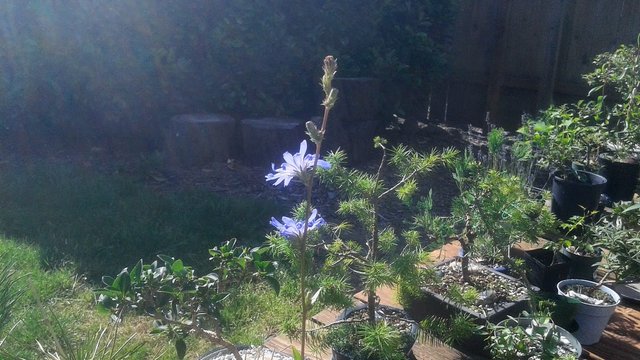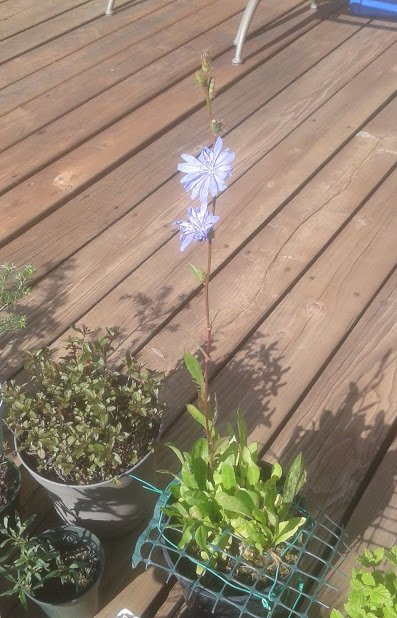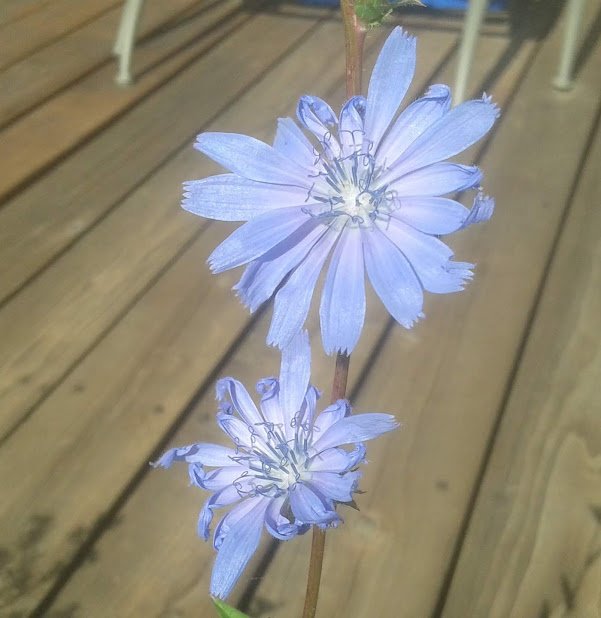Wild Chicory in Bloom [Gardening]

First blooms of Chicory have finally arrived this morning.

These are the same as the flowers that often grow in the dry rocks and hard compacted dirt on the side of roads. They are difficult to transplant because if the taproot breaks, the upper half above the break will die. Seeds are not viable for long. Some people are successful at starting new plants by putting a bare pot of soil underneath a patch of the flowers, and hoping seeds fall into the pot and start to grow. I have not had any luck with this method.
Planted these seeds three years ago. The seeds were a free gift from a fellow on youtube offering seeds to everyone who wanted to grow this magical flower. He told me to plant them in the fall or spring, and wait for the spring the year after to get flowers.
I've had these growing in a pot for three years, and this is the first year they flowered.
Initially I learned that animals like to dig this plant out, and slugs enjoy eating the young sprouts, so I discovered the young plants need to be grown in the shade with a screen to protect the soil from being dug up. I am guessing the young roots of this plant are delicious to eat. They grow best when tightly nestled between other plants in clay soil, because the heavy soil holds the roots more firmly in place.
The leaves look exactly like dandelion leaves to me. Instead of pulling the suspicious weed leaves, I left them alone and let the plants mature in their own time.

Now I have the wonderful blue bee magnets I have been hoping for all these years.
Since my original stash of seeds are no longer viable, I am hoping these flowers continue to produce new seeds, and I can multiply the plants.
Chicory is not the same as Bachelor's Buttons, more commonly sold in seed packets. Chicory is a medicinal herb. The entire plant can be eaten in small doses. The long taproot can be roasted and used in tea.
Other cultivars of Chicory also exist. Usually the vegetable varieties develop a tender crunchy leaf-like cabbage. I am growing some #radicchio elsewhere in the garden which is supposed to be a related species. Radicchio has beet red leaves with white ribbed veins. #Endive (there is a Belgian variety and a French variety) is another popular variety that forms yellow delicate candle shaped wrapped leaves when grown inside a basement with no light source. When these vegetables are grown properly they can be sold for high prices because of the many years of care that goes into making the perfect harvested vegetable.
Some other names for common chicory are #blue-cornflower, wild bachelor's buttons, wild endive, blue dandelion, and blue daisy.

This article has been selected and voted by @omnesplantae Content Curator, visit the discord server for a 360 ° travel experience! https://discord.gg/zd7vFSz
You’ve been visited by @riverflows on behalf of Natural Medicine!
I love blue cornflowers - I didn't realise they were chicory! Can't you drink ground chicory root like you do dandelion root, or am I thinking of something else?
Consider supporting Natural Medicine through continued use of the #naturalmedicine tag, or delegating any amount through clicking below. We're all for empowerment through natural wisdoms, and love to support those on their healing journey. Come join us on Discord if you're not already there! We'd love to have you!
50SPII50SPII100SPII200II500SP
Yes, you are right. Every time someone mentions Chicory, they almost always follow by saying it can be used as a coffee substitute.
It makes a thick white root similar to the dandelion root. I think Chicory is known for having a deeper, thicker taproot than dandelion. These roots are pruned to become very short and fat for growing endive, making for an endless supply of delicious tender leaves.
Interesting!!! Still, I'd prefer coffee - though I have to limit to a cup every few days or I get jittery! - @riverflows